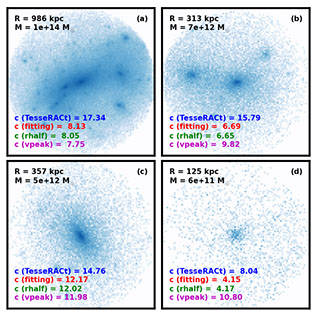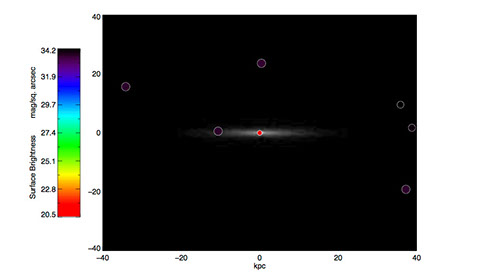
Meagan Lang
Computational Astrophysicist
I am a postdoctoral research associate in the National Center for Supercomputing Applications (NCSA) at the University of Illinois at Urbana-Champaign (UIUC). While my primary research interests center around galaxies and their connection to the large scale structure of the universe, I am also interested in making connections with other scientific domains.
Galaxy Flybys
While flyby interactions between galaxies produce effects that are more subtle than those produced by galaxy mergers, they can still drive significant galaxy evolution. I use numerical simulations to study the role of flybys in galaxy evolution, particularly through the formation of stellar bars. This includes the exploration and characterization of bar identification algorithms that can be used by both theorists and observational astronomers.
Tessellation
Tessellation is mathematical technique for dividing a region of space between a set of arbitrary points. Applications of tessellation include everything from structure identification and surface reconstruction and span a wide range of disciplines. I am interested in developing tools for tessellation and tessellation based analysis that can be used across many different fields of scientific research.
Outreach
I also enjoy connecting the public with the astronomy community through outreach. I am currently working to set up an astronomy outreach group at UIUC aimed at organizing astronomy related outreach both on and off campus. By actively engaging the community we can foster an environment that values scientific research as a whole.
Voronoi Tessellation and Non-parametric Halo Concentration (Lang et al. 2015)
We present and test TesseRACt, a non-parametric technique for recovering the concentration of simulated dark matter halos using Voronoi tessellation. TesseRACt is tested on idealized N-body halos that are axisymmetric, triaxial, and contain substructure and compared to traditional least-squares fitting as well as two non-parametric techniques that assume spherical symmetry. TesseRACt recovers halo concentrations within 0.3% of the true value regardless of whether the halo is spherical, axisymmetric, or triaxial. Traditional fitting and non-parametric techniques that assume spherical symmetry can return concentrations that are systematically off by as much as 10% from the true value for non-spherical halos. TesseRACt also performs significantly better when there is substructure present outside 0.5R200. Given that cosmological halos are rarely spherical and often contain substructure, we discuss implications for studies of halo concentration in cosmological N-body simulations including how choice of technique for measuring concentration might bias scaling relations.
The figure to the right shows the projected mass density of four example halos from M. Sinha et al. (2015, in preparation) with concentrations determined using different techniques in the bottom left hand corner of each panel. The radius and mass of each halo, as identified by Rockstar (Behroozi et al. 2013), are shown in the top left corner.

Bar Formation from Galaxy Flybys (Lang et al. 2014)
Recently, both simulations and observations have revealed that flybys - fast, one-time interactions between two galaxy halos - are surprisingly common, nearing/comparable to galaxy mergers. Since these are rapid, transient events with the closest approach well outside the galaxy disk, it is unclear if flybys can transform the galaxy in a lasting way. We conduct collisionless N-body simulations of three co-planer flyby interactions between pure-disk galaxies to take a first look at the effects flybys have on disk structure, with particular focus on stellar bar formation. We find that some flybys are capable of inciting a bar with bars forming in both galaxies during our 1:1 interaction and in the secondary during our 10:1 interaction. The bars formed have ellipticities >0.5, sizes on the order of the host disk's scale length, and persist to the end of our simulations, ~5 Gyr after pericenter. The ability of flybys to incite bar formation implies that many processes associated with secular bar evolution may be more closely tied with interactions than previously though.
The figure on the right shows the projected mass density of a face-on disk just after closest approach during a flyby with another galaxy of equal mass. The magenta ellipses show examples of the ellipse fits used in one measurement of bar strength. The green arrow points in the direction of the second galaxy and the time since the beginning of the simulation is shown in the upper left hand corner in Gyr.

Can a satellite galaxy merger explain the active past of the galactic center? (Lang et al. 2013)
Observations of the Galactic Centre (GC) have accumulated a multitude of `forensic' evidence indicating that several million years ago the centre of the Milky Way galaxy was teeming with star formation and accretion-powered activity - this paints a rather different picture from the GC as we understand it today. We examine a possibility that this epoch of activity could have been triggered by the infall of a satellite galaxy into the Milky Way which began at the redshift of z = 8 and ended a few million years ago with a merger of the Galactic supermassive black hole with an intermediate-mass black hole brought in by the inspiralling satellite.
The figure on the right shows what the distribution of satellites around the Milky Way might look like today. None of these satellites would be above the observable background yet could still influence the Milky Way.



